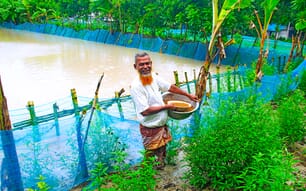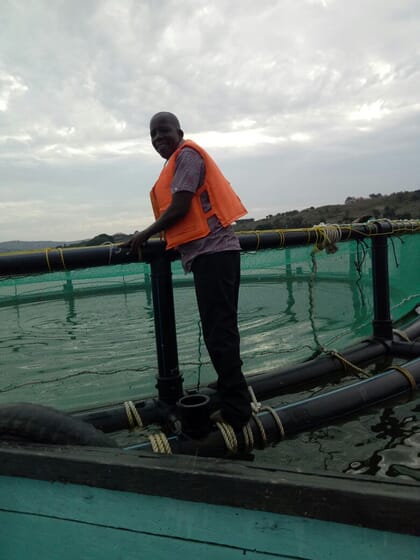
Jewlet Fish Farms has a variety of production systems, including cages with a capacity of 850 tonnes per year, a hatchery and four land-based sites.
What led you to pursue a career in aquaculture?
My interest in aquaculture began during my master's thesis, in 1990, in which I conducted research and sold off fish from 12 research ponds. Most people did not see aquaculture as a viable project but the experience was eye-opening, as we raised almost 1 million KES ($7,806), which was a significant amount of money at the time. This success inspired me to start the University Fish Farm and eventually, the commercial venture, Dominion Farms, which was then the biggest commercial farm in sub-Saharan Africa, besides Lake Harvest in Zimbabwe. Through my breeding programme, I gained recognition and supplied over 80 percent of all the tilapia fingerlings stocked in Kenya during the Economic Stimulus Program (ESP).
What prompted your transition from Dominion Farms to Jewlet Fish Farms?
Dominion was successful, as we were producing a lot of fingerlings and table-sized fish. We had 40-metre diameter ponds with aeration, stocked at 215 fish per cubic metre. I had also started a selective breeding programme. These successes possibility motivated us to do it ourselves and, in 2010, I established Jewlet on a 2.5-acre farm in Kendu Bay.
In 2011, my wife Jedidah, who had been my assistant at Dominion Farms, joined me. Our previous experiences and achievements gave us the confidence to pursue this new venture.
What are your production systems?
Jewlet Fish Farms has a variety of production systems, including cages with a capacity of 850 tonnes per year, and four land-based sites. The hatchery produces 600,000 eggs a week and we have the nursery where we conduct sex reversal, with an efficiency of 98 to 99 percent, which is above the world average of 95 percent. We also have a 4-acre research farm where we do selective breeding and have reached the eighth generation.
Where did you get your initial breeding stock, and how have you maintained the quality?
In 2003, I went to Lake Albert George, Lake Turkana and Lake Kyoga to try to find the best and purest Nile tilapia. One of my clients – a fish processor – had claimed that fish from Lake Kyoga had the best fillets.
I grew these fish independently for two years and realised that he was right and the fish from Lake Kyoga were doing much better. I returned there three times to get fish and sent samples to Malaysia and fin clip samples to Xelect in Scotland. Both results showed that my fish are not inbred. I have always maintained eight lines, and I am in charge of the selective breeding. We do this exclusively in our research farm to make sure there is no interference, and no other production is done there.
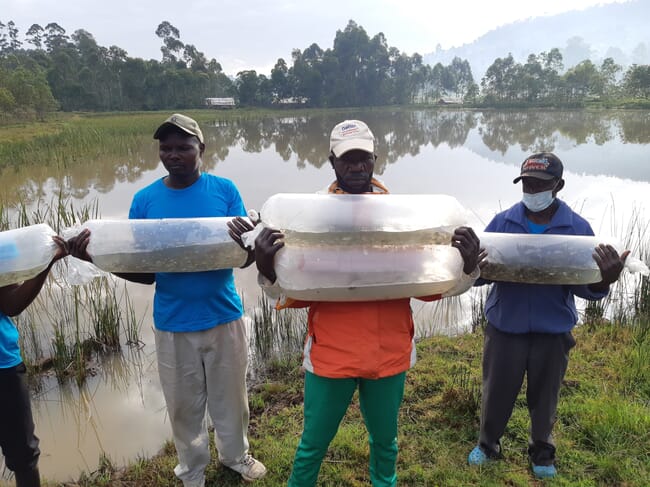
Jewlet can produce 1.2 million fingerlings per month, but has the capacity to produce up to 2.3 million each month.
What products and services does Jewlet Fish Farms offer?
We are the biggest hatchery in Kenya, producing 1.2 million fingerlings per month, with the capacity to produce up to 2.3 million per month. We are also one of the leading cage farmers in Kenya and sell table-sized fish with a mini processing plant. Additionally, we design and sell hapa nets, provide starter feeds for juveniles, and offer after-sales services, consultancy and training. Our training facility has been used by most farms and research institutions in Kenya, as well as many others in East Africa.
How have you found the experience of starting and running your own company?
It’s been an exciting yet tiring experience. Our company sells fish throughout the country and we often wake up at 2 am, sometimes two to three times a week, to harvest and pack fingerlings for delivery. However, my wife, who is our director of operations, has been a great source of support.
What were the biggest challenges of setting up your own aquaculture business?
One of the biggest challenges was getting affordable fish feeds. This happened even during our time in Dominion Farms, when UNGA feeds declined to produce feeds for us, citing economic unfeasibility. As a result, I had to become the feed producer in addition to managing the hatchery and grow-out operations.
At one point I imported feed from Brazil. At the cheapest time, it was $0.97 per kg delivered to my farm. But if the same feed goes to Uganda, and the agent in Uganda sells it to an agent in Kenya, I can pick it from the third party at a cost of $0.80 per kg. Currently it costs about $1.5 per kg. I found out that, even with the current rising prices of transport, the feed that comes through Uganda and then to Kenyan is a little cheaper compared to getting it directly from Egypt or Brazil.
Additionally, the influx of fish from Uganda and China means we face tough competition from cheaper fish imports, which make it difficult to sell our fish at competitive prices.
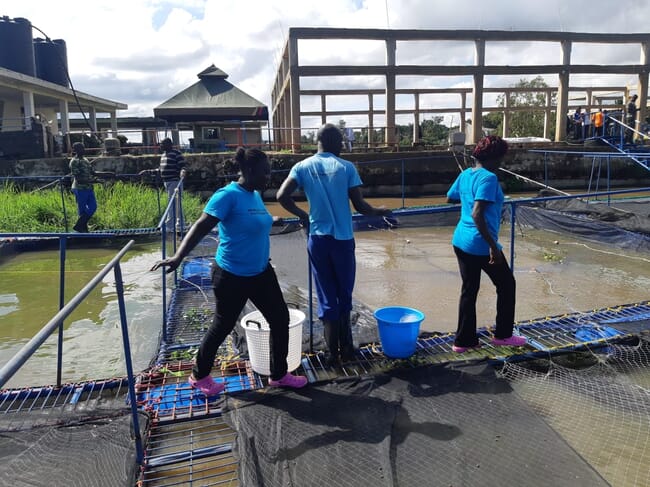
In addition to being one of the leading cage farmers in Kenya, Were's business boasts a mini processing plant, a training facility and feed business.
We also experienced devastating losses during the 2019 flooding in Kenya, where we lost half a million juveniles averaging 20 grams, 1.2 million fingerlings, and about 30,000 broodstock in a single afternoon, all valued at 38.5 million KES ($300,546). This loss was compounded by a separate incident where we lost fish worth 6 million KES ($46,838) due to carelessness by one of our managers. Despite reporting the case to the fisheries department, we did not receive any help.
In addition, the Covid-19 pandemic and theft from our cages have further challenged our business. To address these challenges, we have been reclaiming land affected by flooding and installing CCTV cameras to prevent theft.
Are there any organisations offering some sort of insurance for this type of business?
In sub-Saharan Africa, fish farming is still a relatively new enterprise, and most banks do not understand the business. We tried to explain it to Kenya Commercial Bank (KCB), but most banks are still very scared. They think it's a high-risk business. So far, we are not aware of any farm that is already well insured in Kenya. Sometimes when we move fish or have orders, they insist on transit insurance as a requirement and we can ask the bank to give insurance on transit of the fish. But that's a very short-term solution.
Do you exclusively use your own feeds or do you also buy them?
We make all the starter feeds and juvenile feeds ourselves, including those for our broodstock. However, we import all the pellets for our cage farm, since we stopped making pellets.
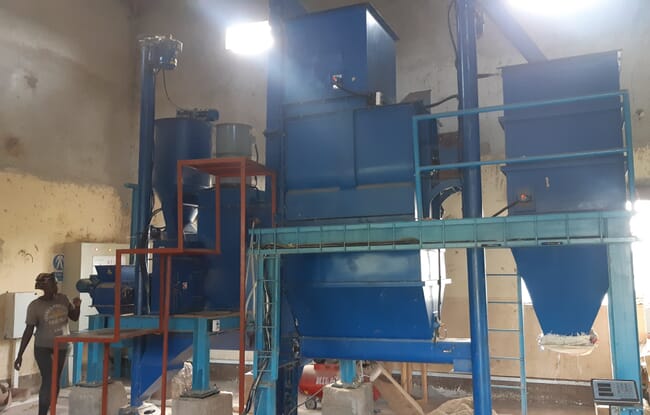
Accessing affordable fish feeds is a recurring challenge in Kenya's aquaculture industry.
What is the biggest challenge of formulating your own feeds?
The biggest challenge is dealing with the ingredients. Sometimes, we encounter bad ingredients and that is why it is crucial to perform rigorous checks to ensure the quality of the ingredients. When ingredients are not kept well/exposed to heat, some of the most important vitamins like vitamin C and vitamin E can be lost. I also stopped using rice bran a long time ago because it absorbs moisture. Furthermore, some ingredients can become contaminated with aflatoxins when they are transported in bad conditions.
How do you deal with parasites and diseases on your farm?
For most of the parasites, we rely on biological means, such as using African lungfish, which are effective snail crushers and snails are often intermediate hosts for many fish parasites. We usually stock one lungfish per 150 m2 of pond. We also keep our farms clean by cutting the grass to keep the snails away. We also fence off most of our farms, we do not have dogs and the farms are usually very busy, which keeps away predators like birds.
Our hatchery uses an RAS system, which includes a UV system and bio-filters to deal with pathogens. Every time we hatch fish, which is about every seven days, we make sure that all the tanks are at least rotationally cleaned. Each of the four incubation tanks, each with four hatching jars, is in turn dried completely, the biofilters are removed, and everything is disinfected. Since we started in 2010, we've never had any diseases or parasites. We are planning to bring in a bigger biofiltration system so that we can have a pool of biofilters before the water is pumped back to the farms.
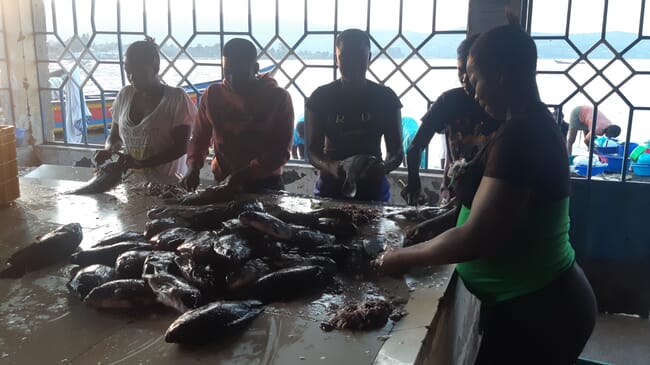
Were has appointed women to key positions at the farm and has seen a positive impact on survival rates and hatchery reliability.
Could you tell me about your unwritten rule for women empowerment in your organisation?
Our first farm was developed in a location with a high poverty level, as it was far from the lake, so people couldn't rely on fishing. During the construction of the ponds, most of the male workers were unreliable, but the women showed up every day. We now aim to have at least 60 percent female employees. Our feed mill is run by a woman. Most of our nursery ponds are also run by females. Sometimes when we had male employees on nightshift in the hatchery, they would sneak out or would be sleeping, and if there were power cuts, we would lose fish because there was no one to turn on the generators. The female employees said they could start working at night. Since that became so, we found them very reliable.
Additionally, because we are in region where sex-for-fish can be an issue, we try to employ women to prevent them being taken advantage of. By empowering women, we are also able to improve the local community, as women are more likely to reinvest their income back into their families and the community.
At the farm, women have taken up key positions and we have seen a positive impact on our survival rates and hatchery reliability. Our cumulative survival rate has improved by almost 25 percent and the reliability in the nursery farms has increased by at least 20 percent compared to when we had more men in charge.
Could you tell me about the aquaculture academy?
This is a training programme for building “aquapreneurs” in East Africa to run sustainable and profitable businesses. I was approached by Lattice Aqua to partner with them. We said yes because we have always been training people and are always willing to share information. We believe that people are not competitors but rather complementary, and it has been our passion to empower others.
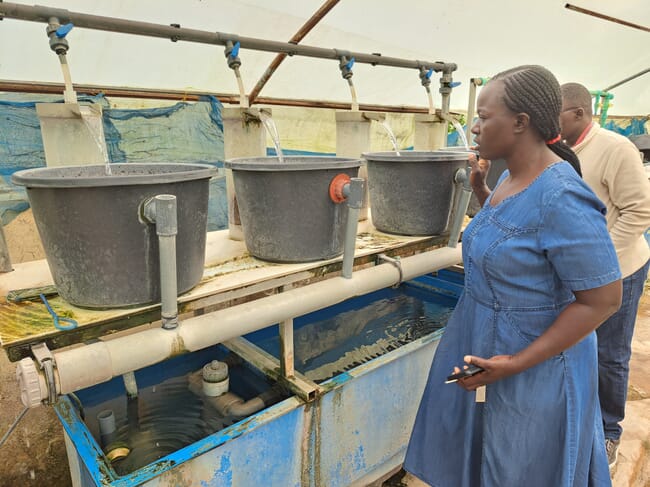
Were invests almost 100 percent of his profits back into the business through a zero balance business model.
How have you financed your own operations and are you looking to raise more money to expand?
We have mostly been funding the project ourselves and have gotten some bank loans with limited external support. We also get paid to train. We invest almost 100 percent of our profits back into the business through a zero balance business model. However, if we could get between $500,000 to $1 million, we would move our cages to increase production, as we don’t always reach our 850 tonne capacity.
With capital we could produce our own feeds, up to 6,000 tonnes of fish a year and stock 1 million fingerlings every month. Doubling our fingerling production would help us raise enough revenue to grow and expand.
We've been getting bank loans which have basically been asset financing. Cooperative Bank financed our 10 turner truck, which we repaid so fast that, even before we finished, they financed our brand new double cabin. We are very good at servicing the loans but sometimes the cost is high and currently the government has increased their interest rates, so we are uncertain about loans.
Equity or grants would do us better, whatever amount it is to catapult us to have a little more money than just our income that we plough back. Prior to the pandemic our income was about 27 million KES ($210,772), then went back to 17 million KES ($132,709). Post-Covid, we had a turnover of 57 million then, after the elections – due to a lot of uncertainties – we went back to around 29 million KES ($226,386). These fluctuations are testing.
What are the key hurdles that aquaculture in sub-Saharan Africa needs to overcome before it can realise its true potential?
The big five problems in sub Saharan African aquaculture are still seed, feed, capital, knowledge and the market.
Can you think of any tools that modern farmers must employ in order to stay competitive?
When we started farming, we did not have access to modern tools and resources such as WhatsApp groups and fish farmer groups, which have become more prevalent now. Additionally, the market information available now is much better. Farmers now have access to programmes that teach them about best practices, such as using cool boxes to preserve fish and how to sample and harvest fish, based on the market demand. For example, farmers now know to remove only the quantities of fish that the market wants, leaving the rest in the pond, which is the best preservative for the fish.
What do you think the government should do to change the aquaculture industry in Kenya?
The government should remove all levies on aquaculture to make Kenyan farmers more competitive. Currently, our neighbours do not have levies on aquaculture, which gives them an advantage. If the government supports farmers and removes the levies, they will generate more revenue through income tax than they would through levies. As the industry grows, it will create more jobs and bring in more revenue, which the government can collect through PAYE and other taxes.
Is this a conversation that has been taken up with the government and what has been the feedback?
Yes, a few individuals, including Professor Ngugi and I, have been at the forefront of commercialising aquaculture and have engaged the government on this issue. We have written policy papers and engaged with the government through partners like Msingi East Africa. We have even paid consultants to show the government what other countries like Uganda have done to promote their aquaculture industries. We hope that the government will listen to us and remove the bottlenecks in the industry, as this will generate more revenue for the country in the long run.
Have you seen a change in government involvement with aquaculture in Kenya over the years?
The government has shown goodwill towards aquaculture, such as through the Economic Stimulus Program (ESP) and the provision of funding through organisations like IFAD. However, financing is not the most crucial factor in the growth of the industry. Removing bottlenecks is more important, as Kenyans have the funds to invest in aquaculture. For example, the Ugandan government has not provided financing for aquaculture, yet the industry has grown due to the favourable environment for investment.
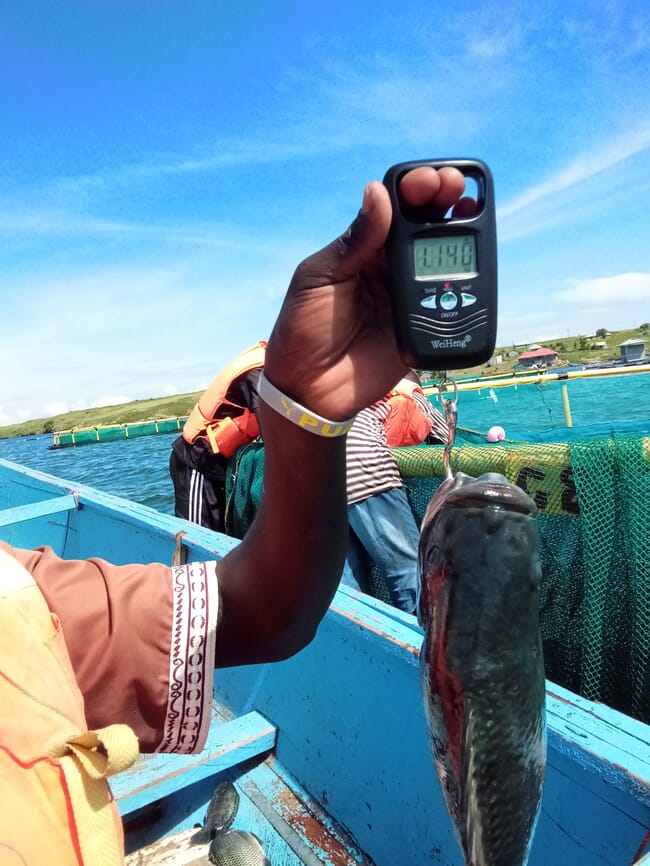
Jewlet's selective breeding programme has been recognised as a standout success in Kenya.
Have you received any recognitions/awards for your work?
I am honoured to have received several recognitions and awards. Jewlet Fish Farms have been a part of several government programmes and the government welcomed us when we wanted to set up cage fish farming.
On a personal level, I am proud to have been one of the reviewers for the World Aquaculture Society journals and I received an award for outstanding reviewers. I have also received an opportunity to travel to Malaysia with the WorldFish Centre for a learning trip on genetics. Moreover, my selective breeding programme has been recognised as the best in the country, and I was awarded a trip to Scotland to learn more about genetics.
Furthermore, I was invited to Accra as part of the African Union (AU) team on animal resources and aquaculture. Through these recognitions, I have had the privilege to travel extensively and expand my knowledge in aquaculture. Jedidah has also received similar recognition for her contribution to the industry. We are grateful for these opportunities, and they serve as a motivation to continue improving aquaculture.


